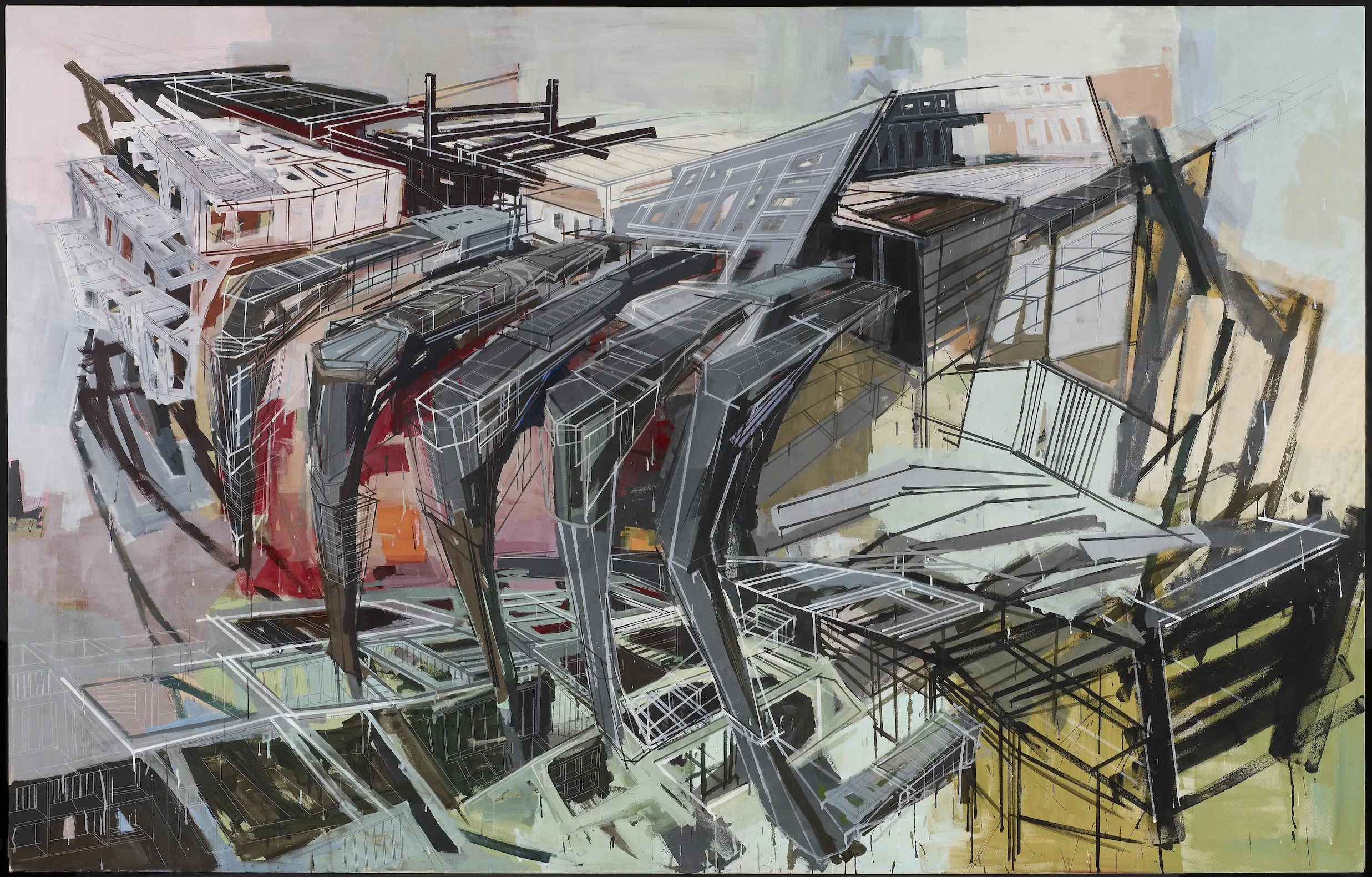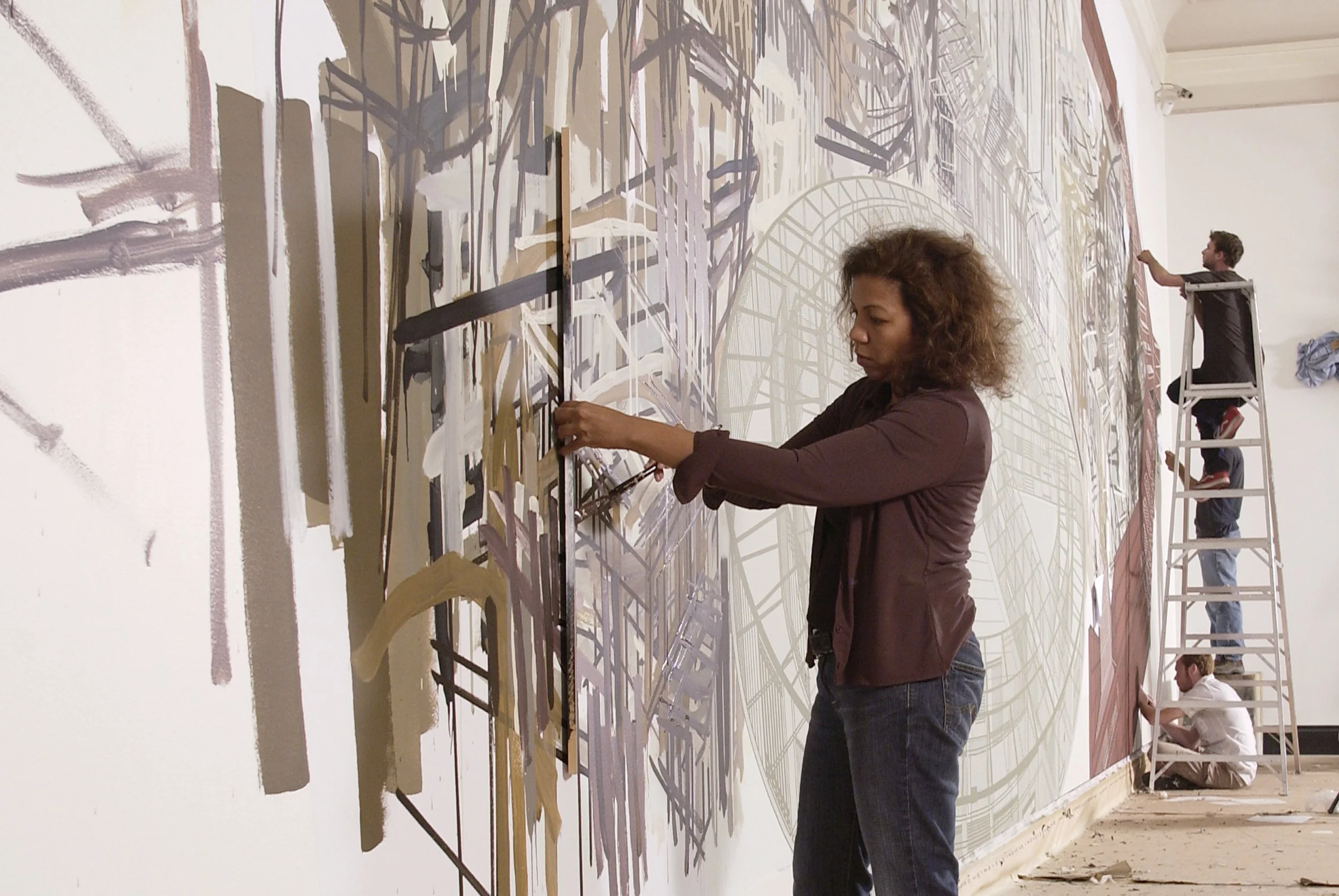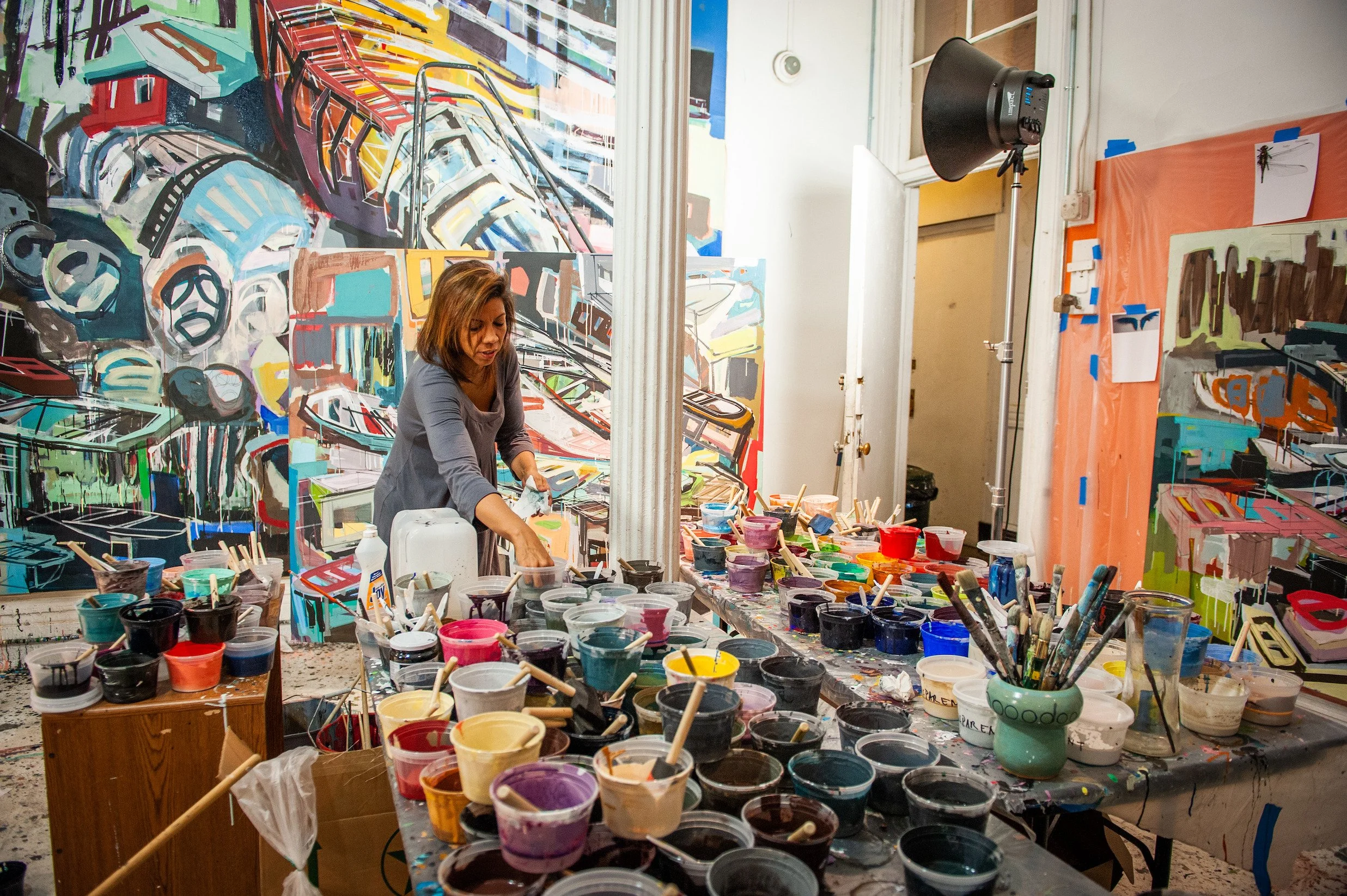Denyse Thomasos' creative brilliance on display at Art Gallery of Ontario
October 21, 2022
At the behest of a Grade 7 teacher, Denyse Thomasos attended a weekend art program and thoroughly enjoyed the experience.
“I think that was what really sparked her interest in the creative arts,” said younger sister Gail Luciano.
In high school, Thomasos transferred to an institution with a special program in the arts where she shone and subsequently pursued Painting & Art History at the University of Toronto and a Master in Fine Arts in Painting & Sculpture at Yale University. She graduated in 1987 and 1989 respectively.
Moving to New York to pursue a painting career and joining academia, the Rutgers University professor, who taught painting, drawing and printmaking, died suddenly in July 2012 at age 47.
Prior to joining Rutgers where she spent 27 years, Thomasos was an Assistant Professor, Fine Arts at Temple University’s Tyler School of Art.
To mark the 10-year anniversary of her death, family members attended an exhibition showcasing Thomasos’ work on October 10 – it would have been her 57th birthday -- at the Art Gallery of Ontario (AGO).
A career retrospective, ‘Denyse Thomasos: Just Beyond’, brings together more than 70 paintings and works on paper, many rarely seen, to show how she challenged the limits of abstraction by infusing personal and political content onto her canvases through the innovative use of formalist techniques.
Through patterns, scale and repetition, she conveys the vastness of events, including the transatlantic slave trade without exploiting the images of those who were most affected.
Denyse Thomasos. Metropolis, 2007. Acrylic, charcoal, porous- point marker on canvas, unframed: 214 x 335.6 x 3.5 cm. Art Gallery of Ontario. Purchased with the assistance of the Toronto International Art Fair 2007 Opening Night Preview, and with the Financial Support of the Canada Council for the Arts Acquisition Assistance Program, 2008. © The Estate of Denyse Thomasos and Olga Korper Gallery. 2007/241
Thomasos’ family greeted the historic exhibit with mixed emotions.
“While we are excited and happy, Denyse is not here to celebrate as well,” noted Luciano. “We chose her birthday to come here, share memories and celebrate her life.”
The learning and organizational consultant shared a story to illustrate her sister’s creativity at a young age.
“When Denyse was young, our mother sold Avon and she put on a sale about once a year for the leftover products,” related Luciano. “Denyse did these little signs with caricature pictures on them that was used to promote the sale. We had an aunt in Washington D.C who was a graphics designer and she was very impressed with my late sister’s calligraphy signs. She suggested Denyse do a calligraphy course which she did. There were always signs of her artistic talent and she was encouraged.”
Dr. Tamara Mose was an intimate part of her cousin’s academic life.
“I had opportunities to see her classrooms and art spaces at Rutgers University and talk about her career trajectory as she was going up for promotion,” said the Brooklyn College Sociology Department faculty member. “She loved those spaces and seemed joyful when discussing the students and their eagerness to learn.”
Mose vividly recalls the day Thomasos asked her to review her curriculum vitae and academic statements before going up for promotion.
“She felt what many academics feel which is some form of imposter syndrome,” Mose added. “I reassured her that she had a solid record of work and, with a few tweaks, there was no possibility of her being denied. She was so happy and relieved.”
Organized chronologically, the exhibition features sections devoted to the artist’s primary areas of research, illustrated with major works on loan from museums and private collections in Toronto, Montreal and New York City. Working closely with her family and gallerist, curators supplement the exhibition with sketches, photographs and newly uncovered documentary footage of Thomasos working in her studio.
The exhibition will also be accompanied by a fully illustrated 180-page catalogue, co-published by AGO, Remai Modern and DelMonico Books.
Sally Frater co-curated the exhibit with Renee van der Avoird and Michelle Jacques.
van der Avoird is the AGO Assistant Curator of Canadian Art, Jacques is the Head of Exhibitions & Collections and Chief Curator of Contemporary Art at Remai Modern, Saskatoon and Frater is the Oakville Galleries Executive Director.
“The project had been already conceived of when I came on, but in discussion with Renee, we expanded the focus slightly and then Michelle came on as the third curator and we shifted it a little bit more,” said Frater. “Through our discussions, we decided to include archival material that hadn’t been shown before. We worked together to determine the exhibition checklist and what we wanted to say through the project. All of this was done in service of the idea of communicating the scope and breadth of Denyse Thomasos’ artistic practice to audiences in Toronto and beyond.”
It is the first large scale retrospective of Thomasos’ work that includes archival material and examples of her work as a student.
“Some people may not be familiar with the fact that she actually started out as a figurative painter,” Frater noted. “She painted portraits and did figure study before moving into abstraction that drew a connection between architecture in geographic space, place and memory and the transatlantic slave trade and other atrocities that have happened throughout history. She really had a lot of empathy for the human condition. With the overall exhibition, visitors will leave with an understanding of the enormity of her talent and her different ways of working.”
Though she didn’t get the opportunity to meet Thomasos, Frater was familiar with her work.
“I knew she was an abstract painter and I knew she used colour in a really inventive way that helped to communicate the concept of her work, but I didn’t know her work intimately,” she pointed out.
The use of colour along with the rigorous amount of planning and research that went into the development of Thomasos’ work impressed Frater.
“The way in which intuition guided her practice and just how prolific she was during her lifetime also stood out for me,” said the former Art Gallery of Guelph Contemporary Art Curator. “She was so ambitious. A lot of the themes that underpin her work resonate with me and the way in which her own personal experience informed the work that she did. She was able to channel her own personal history and experience into her work in really poetic and impactful ways.”
Frater, who curated nearly 60 solo and group exhibitions, said Thomasos made a very singular and unique contribution to Canadian painting that, though recognized in her lifetime, was in some ways overlooked.
“I think that although she didn’t see herself as taking up some of the concerns of the well-known or abstract modernist painters, her work certainly does fit into that trajectory,” said the former resident in the Core Critical Studies fellowship at the Museum of Fine Arts Glassell School. “She sort of blew open the idea that abstract work should not contain anything that can be interpreted as political or personal. Instead, she showed it can be used as a platform for exploring social justice, issues of race, memory and history.”
The exhibition opens with a large-scale photograph of the artist at work. While under renovation 17 years ago, the AGO invited contemporary artists to create site-specific wall works. Thomasos produced ‘Hybrid Nations’, a massive mural that mixed computer-generated images with hand-painted details. The photograph captures the artist at work, finessing the mural’s imagery of cell, ribs and walls around a roofless panopticon that she hoped would remind viewers of the connection between the present-day prison industrial complex and the transatlantic slave trade.
Installation view: Swing Space: Wallworks, Art Gallery of Ontario. Denyse painting Hybrid Nations at the AGO in 2005. © The Estate of Denyse Thomasos and Olga Korper Gallery, Photo © AGO.
In 2008, she received a $50,000 grant from the Maryland Institute College of Arts in Baltimore to conduct research on privatized super jails.
Thomasos’ work, opined Frater, was prescient.
“She was ahead of her time in the way that she was exploring what we now call carceral aesthetics which is artwork made by people who are incarcerated or out of the prison industrial complex in the United States,” the daughter of immigrants said. “She also wove together these immigrant experiences of movement, about psychological and physiological mapping, in a way in which she was able to collapse the distance between different geographies and historical events. There were people who were doing that work and will continue to do that work, but looking at Denyse’s work that was dealing with the prison system and race allowed what she did to take on extra resonance. Her work was always relevant, but it just hit differently at this current moment.”
Included in the exhibition are selections of her graduate student collection, ‘Babylon’, which is a reflective of the shifts happening in Thomasos’ work in the mid-2000s and is on loan from the University of St. Michael’s College Donovan Collection.
Denyse Thomasos with Babylon in New York City Studio in 2005 (Photo by Samien Priester)
The exhibition concludes with the massive six-by-three metre canvas, ‘Arc’, which the AGO recently acquired with the support of Women’s Art Initiative. ‘Arc’ reveals traces of the artist’s body through swoops, strokes and drips of paint. The largest scale she worked on, the canvas is the same size as the wall in Thomasos’ East Village, New York studio.
Denyse Thomasos in her studio with Arc in the background, February 8, 2010. © The Estate of Denyse Thomasos and Olga Korper Gallery, Photo © Nancy Borowick.
‘Arc’ is one of Frater’s favourite pieces.
“When I look at images of that work, I have a kinesthetic experience,” she said. “I see all of the colours and the different forms and lines and I can actually hear sound. That painting is so powerful.”
Migrating with her family from Trinidad & Tobago in 1970, Thomasos attended the Skowhegan School of Painting & Sculpture and did her first solo exhibition in 1995 at Alpha Gallery in Boston.
As an abstract painter, she focused on developing a body of architectonic works that can be read narratively.
“I began with a single unit of space wherein I recorded various line patterns that could be read descriptively, much like a journalistic entry of mood or emotional state,” Thomasos said in May 2012. “My large-scale paintings were made up of a variety of units, all varying in line quality. I saw the potential for communicating a narrative much as one would see in a figurative or representational painting.”
During a distinguished career, the acclaimed painter attended several residencies and won numerous prestigious awards, including a Harry Jerome Award in 1987 for creative excellence and the Guggenheim Fellowship Prize a decade later.
The exhibition ends on February 23, 2023.










